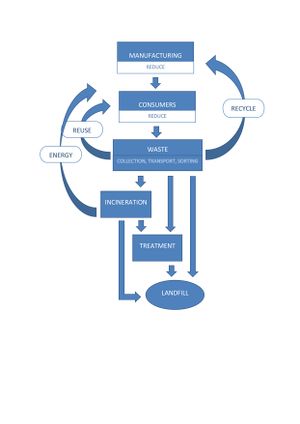Integrated waste management: Difference between revisions
(Infobox update) |
(The LinkTitles extension automatically added links to existing pages (<a target="_blank" rel="noreferrer noopener" class="external free" href="https://github.com/bovender/LinkTitles">https://github.com/bovender/LinkTitles</a>).) |
||
| Line 19: | Line 19: | ||
The goal of IWM is to reduce the environmental effects by using all feasible waste management methods - in particular '''reduction/reuse/recycling''' and '''incineration''' - in addition to landfill. | The goal of IWM is to reduce the environmental effects by using all feasible waste management methods - in particular '''reduction/reuse/recycling''' and '''incineration''' - in addition to landfill. | ||
Non-recyclable waste should be subject to a safe disposal process. | Non-recyclable waste should be subject to a safe disposal process. | ||
The [[planning]] and application of an integrated waste management system is a multi-factorial [[project]] and has to consider many aspects, such as demographic change, [[market]] availability for re-cycled goods, and the accessibility of land and other assets. | The [[planning]] and application of an integrated waste [[management system]] is a multi-factorial [[project]] and has to consider many aspects, such as demographic change, [[market]] availability for re-cycled goods, and the accessibility of land and other assets. | ||
[[File:Block diagram illustrating overall integrated waste management system.jpg|300px|right|thumb|Fig. 1 Block diagram illustrating overall integrated waste management system.]] | [[File:Block diagram illustrating overall integrated waste management system.jpg|300px|right|thumb|Fig. 1 Block diagram illustrating overall integrated waste management system.]] | ||
Revision as of 07:16, 20 January 2023
| Integrated waste management |
|---|
| See also |
Integrated Waste Management (IWM) covers the waste management hierarchy by taking into account immediate effects (transport, collecting, treating and disposing of waste) and indirect effects ( both use of waste materials and energy outside the waste management system). It is a structure that can be used to opt for existing systems as also to plan and implement new waste management systems. IWM is as well a transformation process that progressively introduces waste management from all utilities (solid, liquid and gaseous).
An integrated waste management strategy is mandatory by law in many different jurisdictions.
The goal of IWM is to reduce the environmental effects by using all feasible waste management methods - in particular reduction/reuse/recycling and incineration - in addition to landfill.
Non-recyclable waste should be subject to a safe disposal process.
The planning and application of an integrated waste management system is a multi-factorial project and has to consider many aspects, such as demographic change, market availability for re-cycled goods, and the accessibility of land and other assets.
IWM classes
The parameters constituting integrated waste management are divided into four classes:
- integration into a single facility (solid, aquatic or atmospheric waste) by examining possible new options for waste management,
- multimedia integration (solid, aquatic, atmospheric and energy waste) by exploring waste management alternatives that can be used for more than one utility
- tools (regulatory, economic, voluntary and informational); and
- representatives (governmental — local and national, business and community).
The main environmental problem is the amount of waste generated which exceeds the capacity of the environment to absorb or manage it by the authorities which is the result of rapid urbanization and population growth. Integrated waste management demands a holistic attitude that includes an insight into the life cycle of goods and services. This in turn calls for the integration of various disciplines in initiating and analysing an integrated waste management system that takes to sustainable development.
References
- Prashanthi, M., Sundaram, R. (2016). Integrated Waste Management in India: Status and Future Prospects for Environmental Sustainability. Springer, 19-20.
- Seadon, J.K. (2006). Integrated waste management – Looking beyond the solid waste horizon. PubMed, 1-2.
- Tammemagi, H.Y. (1999). The Waste Crisis: Landfills, Incinerators, and the Search for a sustainable future. Oxford University Press, 33-36.
- Wilson, D.C., Rodic, L., Cowing, M.J. et al. (7 more authors) (2015). ‘Wasteaware’ Benchmark Indicators for Integrated Sustainable Waste Management in Cities. Waste Management, 1 - 8.
Author: Patrycja Róg
